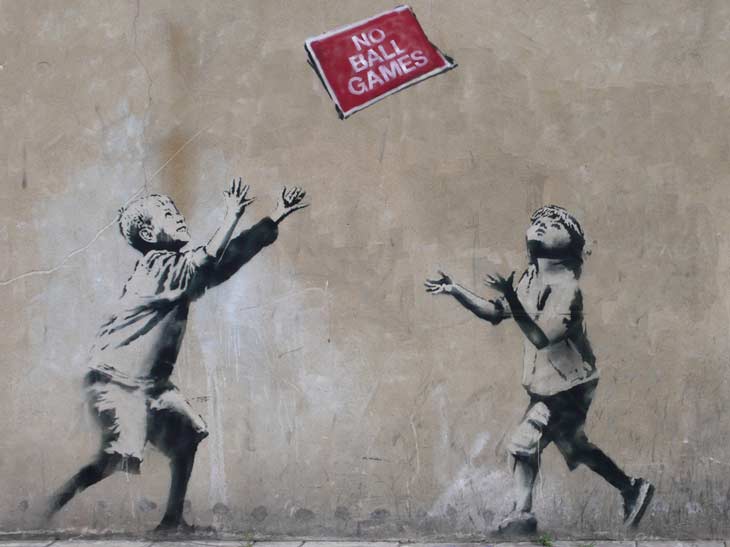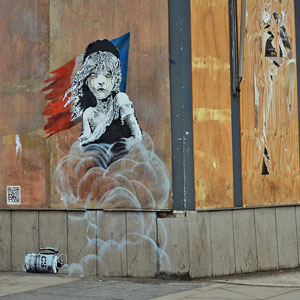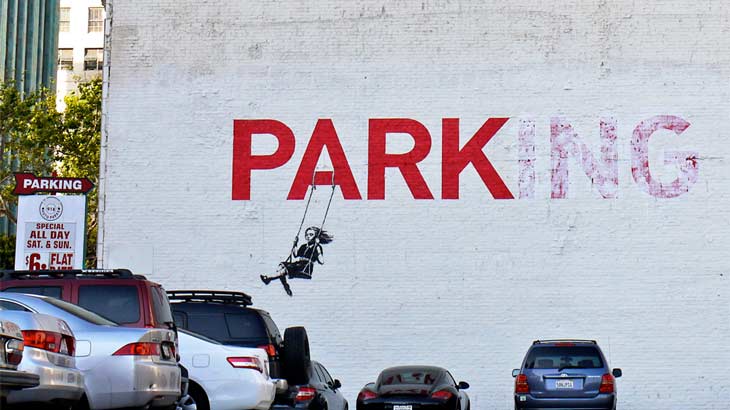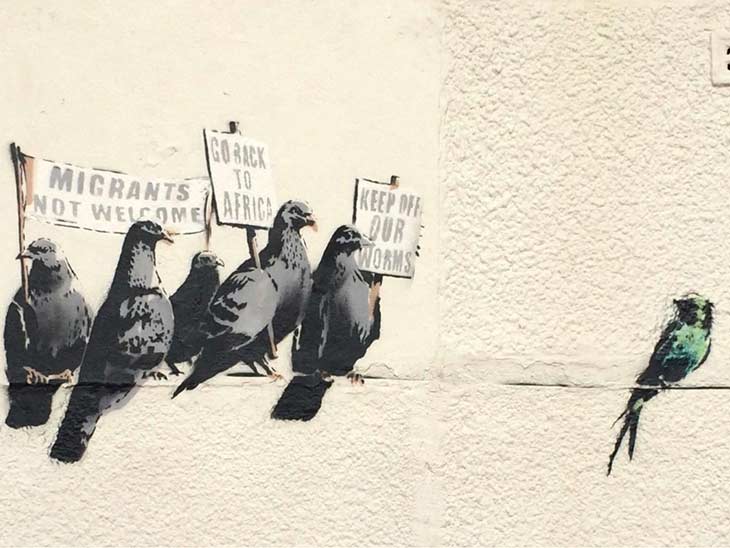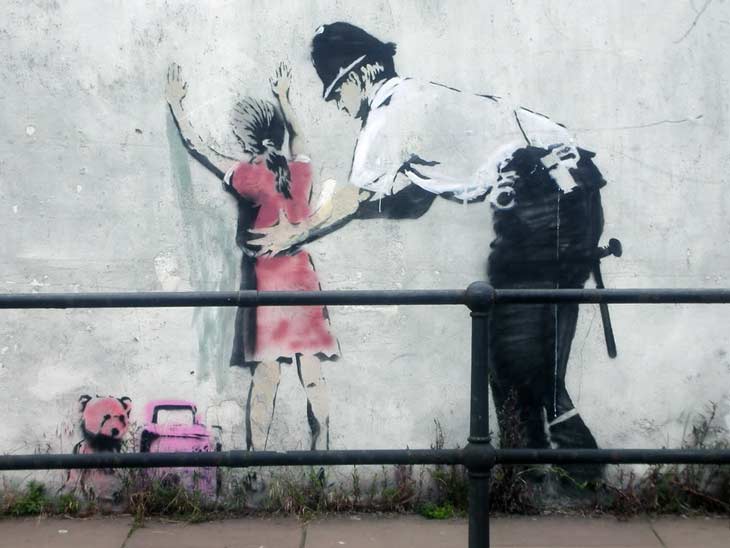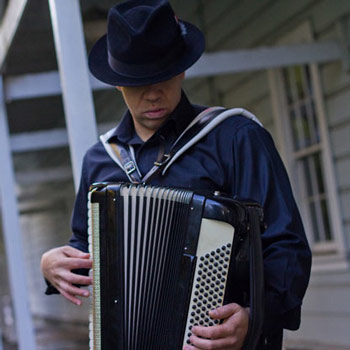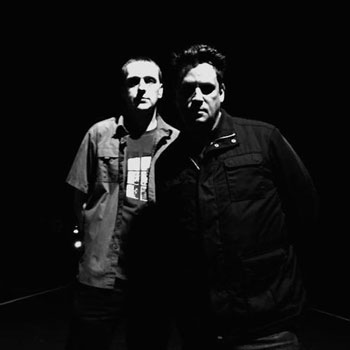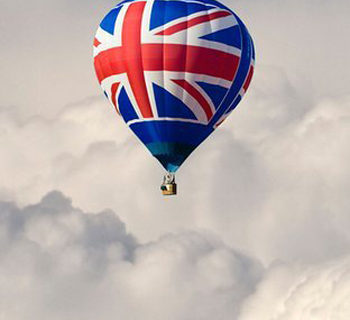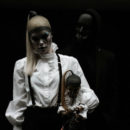Putting a Price on Banksy: Refugees, Gallery Owners, and Global Corporations Profit from Anti-Capitalist Street Art
Banksy is everything you wish you could be. He’s the enigmatic, subversive, brazen troll of the bourgeois art world—“bombing” cities with blunt political messages and social critiques armed with only a stencil and spray paint. His anonymity and apathy toward fame only serve to entice his fans, while his cheeky dismissal of the rules (he once scotch-taped his own artwork to a wall in the Museum of Modern Art without permission) only raises the value of his art. “I think a museum is a bad place to look at art,” Banksy once explained in a rare interview with the Guardian, “the worst context for art is other art.”
One recent venue was a dreary seafront compound near a low-income neighborhood in Somerset, England where he installed a semi-functional and fully tongue-in-cheek theme park called “Dismaland,” effectively satirizing capitalism through one of its most beloved, family-friendly venues. In an interview he did with Juxtapoz Magazine about the project, he described “Dismaland” as “a place where you can get your counterculture easily available over the counter, a theme park for the disenfranchised, with franchises available.”
In 2010 Banksy released his documentary Exit Through the Gift Shop, which won numerous awards and a nomination for best documentary at the Academy Awards, despite mocking award shows in the trailer. In the film, Banksy documents Theirry Guetta, a French immigrant making a documentary about another underground street artist in Los Angeles. Eventually, as Banksy and Guetta form a friendship, Guetta begins to film Banksy. What follows is a ridiculous series of ironic plot twists within plot twists sparking widespread, although unconfirmed, speculation that the entire film was a hoax, or a “mockumentary”. On the other hand, it was so perfectly absurd that it almost had to be real, as new evidence suggests.”
Either way, irony is present throughout all of Banksy’s work, (or, perhaps, is Banksy’s work), and it is the driving force behind his commanding messages. His anti-capitalist messages reside inside a capitalist world that is squarely opposed to everything he stands for. By highlighting contradiction, pieces like “Dismaland” suggest that rather than draw power from solidarity and similarity, our voices are more impactful when they face the opposition by stealing their platform, turning it upside down, and then spitting it back out.
But Banksy is not the only one capable of turning a message on its head. From Etsy sellers to global corporations, many have used his stance against copywriting and commercializing his own work in order to reproduce and sell his most recognizable pieces on shirts, mugs, and posters. For a while, you could actually buy a reproduced "Destroy Capitalism" Banksy print at Walmart, starting at $57.99. How’s that for irony?
Earlier this year a group of Turkish investors, together with Banksy’s estranged former agent and current gallery owner Steve Lazarides, unveiled an unauthorized Banksy retrospective featuring 80 of his works in a new gallery in Istanbul, complete with a “fake” gift shop (a reference to his film title) that in fact carried very real mugs, t-shirts, and prints of his art for sale.
“My aim is to make him more commercial and more commercial and more commercial,” Mr. Gürkaynak, one of the investors, said. The organizers argue that commercializing his work brings his message to a global audience, and this is particularly salient in a city that is home to large numbers of Syrian refugees.
If the medium is the message, as it certainly has been with street art, does the use of the enemy’s tools and platform strengthen or weaken Banksy’s message? What happens to anti-establishment rhetoric when it’s not only accepted, but promoted by, the establishment? Is Banksy the one playing the game, or the one being played?
The leftover structures from Dismaland were dismantled, transported, and reassembled as housing and play structures in Calais, a port city in France currently receiving a large number of Syrian refugees. On a wall in the refugee camp, Banksy recently painted a mural of Steve Jobs, biological son of a Syrian refugee and also one of the most successful entrepreneurs in history, carrying a sack of his possessions and an old Macintosh computer, titled “Son of a Migrant from Syria.” Journalists who visited the site to photograph the piece reported that it was covered by a blanket, and another entrepreneurial migrant nearby told visitors they would be charged to view the piece. How much to see the original Banksy? Five euros.

